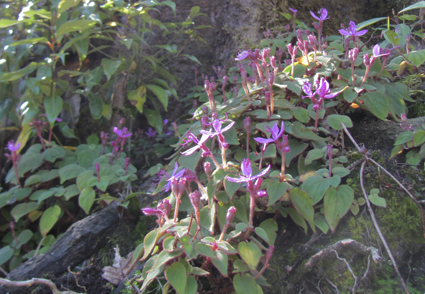Abstract
Two new species, Sonerila cornuta and S. phaluongensis, discovered in Vietnam, are described and illustrated. The first, superficially similar to S. reptans, however, it is distinguished by an obclavate hypanthium (vs. cylindrical-campanulate or obconical) and purple anthers (vs. yellow), with the base having two prominent S-curved lobes (vs. lobes at the base of anther short, inconspicuous). The second, is morphologically similar to Sonerila betongensis but differs in having a quadrangular, 4-winged stem (vs. terete), glabrous leaves (vs. densely hispid), shortly cylindrical hypanthium (vs. cupuliform to campanulate) that is sparsely covered with glandular hispid hairs (vs. relatively densely hispid with simple hairs), and the anther base with two prominent lobes (vs. small, inconspicuous). In addition to the formal description, line drawings, color plates, information on distribution, ecology, and conservation status, as well as comparisons with morphologically similar species, are provided for each species.
References
- Beentje, H. (2016) The Kew Plant Glossary, an illustrated dictionary of plant terms (2 edition). Royal Botanic Gardens, Kew, 184 pp.
- Chen, J. & Renner, S.S. (2007) Melastomataceae. In: Wu, Z.Y. & Raven, P.H. (Eds.) Flora of China, Vol. 13. Science Press, Beijing, pp. 360–399.
- Cho, S.H., Lee, J.H., Won, H., Phourin, C. & Kim, Y.D. (2015) Sonerila bokorense (Melastomataceae), a new species from Cambodia. Phytotaxa 222 (4): 295–299. https://doi.org/10.11646/phytotaxa.222.4.8
- Dang, V.S., Nguyen, H.Q., Pham, H.D., Pham, V.N., Mai, T. & Hoang, N.S. (2016) Two new records for the flora of Vietnam: Sonerila (Melastomataceae) and Erycibe (Convolvulaceae). Plant Science Today 3 (4): 349–353. https://doi.org/10.14719/pst.2016.3.4.256
- Harris, J.G. & Harris, M.W. (2006) Plant identification terminology: an illustrated glossary. Spring Lake Publishing, Spring Lake, 216 pp.
- Hickey, M. & King, C. (2013) The Cambridge Illustrated Glossary of Botanical Terms. Cambridge University Press, Cambridge, 208 pp.
- IUCN Standards and Petitions Committee (2024) Guidelines for Using the IUCN Red List Categories and Criteria. Version 16. Prepared by the Standards and Petitions Committee. Available from: http://www.iucnredlist.org/ (accessed 8 February 2025)
- Liu, Y., Veranso-Libalah, M.C., Kadereit, G., Zhou, R.C., Quakenbush, J.P., Lin, C.W. & Sae Wai, J. (2022) Systematics of the Tribe Sonerileae. In: Goldenberg, R., Michelangeli, F.A. & Almeda, F. (Eds.) Systematics, Evolution, and Ecology of Melastomataceae. Springer, Cham, Switzerland. https://doi.org/10.1007/978-3-030-99742-7_15
- Nguyen, D.D., Nguyen, V.C. & Lin, C.W. (2024) Sonerila dongii (tribe Sonerileae, Melastomataceae), a new species from Lam Dong province, South Vietnam. Phytotaxa 663 (3): 149–156. https://doi.org/10.11646/phytotaxa.663.3.4
- Phonepaseuth, P., Souladeth, P., Souvannakhoummane, K., Vongthavone, T. & Tagane, S. (2021) Two new species of Sonerila Roxb. (Melastomataceae) from Laos. European Journal of Taxonomy 55: 136–148. https://doi.org/10.5852/ejt.2021.755.1403
- Renner, S.S., Clausing, G., Cellinese, N. & Meyer, K. (2001) Melastomataceae. In: Santisuk, T. & Larsen, K. (Eds.) Flora of Thailand, Vol. 7 (3). Prachachon Co. Ltd., Bangkok, pp. 412–497.
- Roxburgh, W. (1820) Flora Indica. Calcutta botanic garden, Serampore, 493 pp
- Sae Wai, J. & Hu, J.M. (2020) Sonerila calcicola (Melastomataceae), a new karst dwelling species from Northern Thailand. Kew Bulletin 75: 43. https://doi.org/10.1007/s12225-020-09901-8
- Sae Wai, J. & Hu, J.M. (2023) Twelve new species of Sonerila (Sonerileae, Melastomataceae) from Thailand. Phytotaxa 620 (2): 107–142. https://doi.org/10.11646/phytotaxa.620.2.1
- Shin, J.S., Song, B.K., Phourin, C., Won, H., Lee, K.E. & Cho, S.H. (2020) Sonerila cardamomensis (Melastomataceae), a new species from Cambodia. PhytoKeys 156: 139–144. https://doi.org/10.3897/phytokeys.156.55866
- Simpson, M.G. (2019) Plant systematics. 3 ed. Elsevier, Amsterdam, 761 pp.
- Stapf, O. (1892) On the Sonerileae of Asia. Annals of Botany 6: 291–323.


